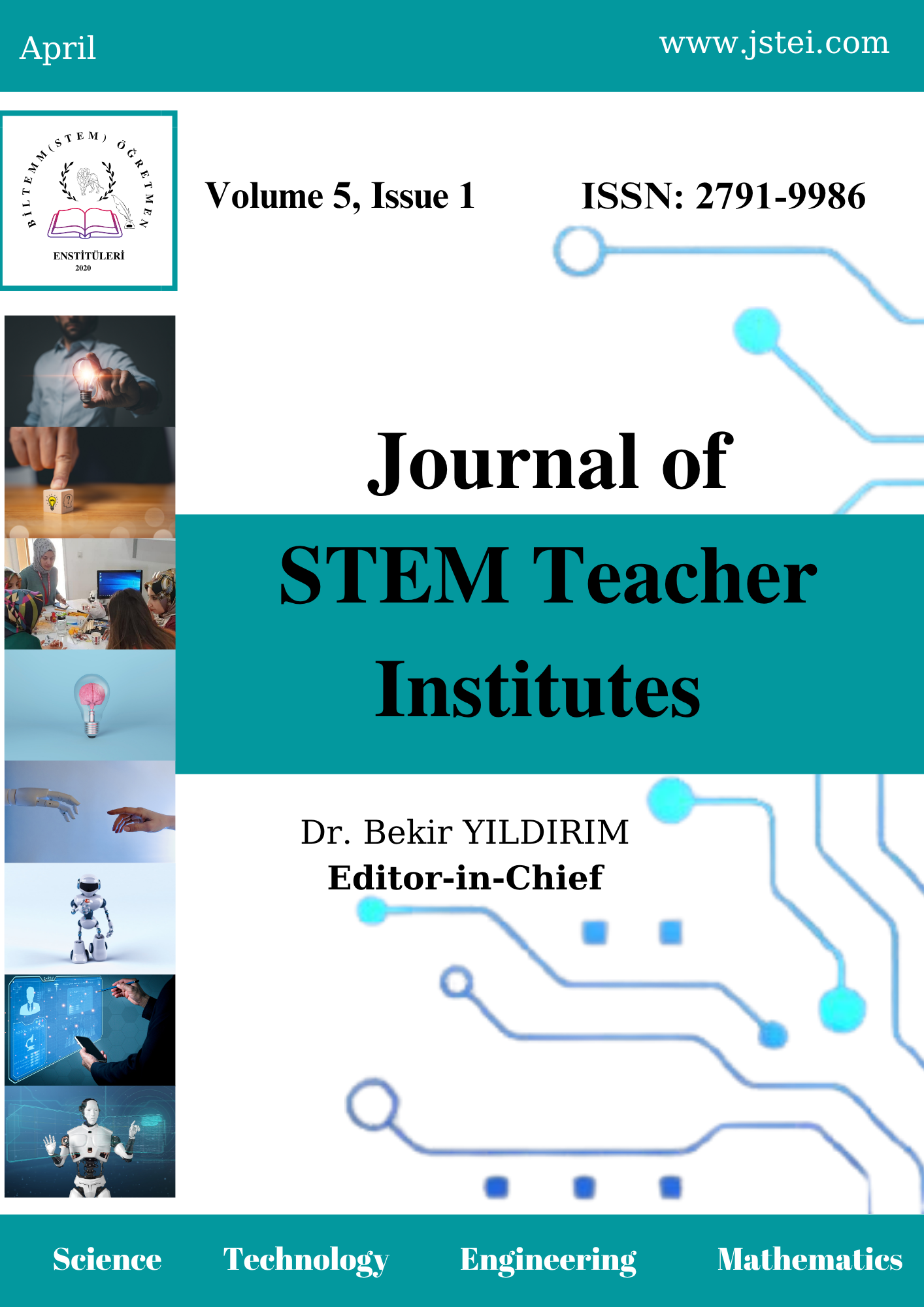Prospective Elementary Mathematics Teachers’ Views on the Use of Islamic Geometric Patterns in Mathematics Lessons
Keywords:
Islamic Geometric Patterns, Interdisciplinary Learning, Creativity, Instructional Design Skills, Cultural ContextAbstract
This study aims to examine the views of prospective elementary mathematics teachers regarding the use of Islamic Geometric Patterns (IGPs) in mathematics lessons. Conducted within a qualitative research design, the study collected data from seven teacher candidates—third-year students who had taken an elective course on IGPs—through a semi-structured interview form. The data were analyzed using content analysis, and a descriptive approach was adopted to interpret the findings based on themes, categories, and codes. The analysis revealed that the experiences and opinions of the teacher candidates about the use of IGPs were grouped under seven main themes: “Interest and Attitude Towards Mathematics,” “Establishing Interdisciplinary Context,” “Creativity and Instructional Design Skills,” “Visualization and the Concretization of Geometric Concepts,” “Integrating Historical and Cultural Context into Teaching,” “Limitations and Challenges,” and “Suggestions for Effective Utilization.” The findings indicate that IGPs can contribute to developing positive attitudes toward mathematics, fostering interdisciplinary integration, supporting creativity and instructional design skills, facilitating the understanding of geometric concepts, and providing a cultural-historical perspective. However, issues such as time management, topic alignment, and material shortages may prevent smooth implementation in every context. The study highlights that IGPs can serve as a potential tool for enriching mathematics teaching, enhancing students’ motivation and comprehension levels, and encourages the development of guiding resources, technological support, collaborative activities, and practical applications to realize this potential.
References
Aktaş, M., Aktaş, S., Aktaş, B. K., & Aktaş, B. (2015). Süslemede simetrinin etkisi. Gazi Üniversitesi Gazi Eğitim Fakültesi Dergisi, 36(1), 41-64.
Aktaş, M., Ercan, L., & Bulut, G. G. (2024). Süsleme sanatının içindeki simetri çeşitlerinin Geogebra ile öğretimin öğretmen adaylarının başarısına etkisi. Journal of Social, Humanities and Administrative Sciences (JOSHAS), 8(58), 1637-1642.
Aydin-Güç, F., & Hacisalihoglu-Karadeniz, M. (2020). Determination of students' performance in tessellations. Acta Didactica Napocensia, 13(1), 189-200.
Braun, V., & Clarke, V. (2006). Using thematic analysis in psychology. Qualitative Research in Psychology, 3(2), 77–101.
Bush, O. (2021). Color and geometry in the Alhambra: And what got lost in the Alhambresque. Manazir Journal, 3, 13-29.
Callingham, R. (2004). Primary students' understanding of tessellation: An initial exploration. In Proceedings of the 28th Conference of the International Group for the Psychology of Mathematics Education.
Capone, R., Adesso, M. G., Manolino, C., Minisola, R., & Robutti, O. (2024). Culturally crafted lesson study to improve teachers' professional development in mathematics: A case study in Italian secondary school. Journal of Mathematics Teacher Education, 27(4), 607-636.
Chang, W. (2018). Application of tessellation in architectural geometry design. In E3S Web of Conferences (Vol. 38, p. 03015). EDP Sciences.
Creswell, J. W. (2013). Qualitative inquiry and research design: Choosing among five approaches (3rd ed.). SAGE.
Eryılmaz, H. İ., & Selimgil, B. (2021). İslam eserlerinde kullanılan altıgen tabanlı geometrik desenlerin çözümlenmesine yönelik yeni bir yaklaşım. Mizanü'l-Hak: İslami İlimler Dergisi,(12), 217-254.
Hemmerling, M. (2019). Shell structures vs. tessellation patterns, a didactic experiment between architecture and mathematics. Journal for Geometry and Graphics, 23(1), 127-137.
Ilucová, L. (2004). Tessellations by polygons in mathematics education. In Researching the Teaching and Learning of Mathematics II (pp. 161-166).
İpek, J., & Özmüş, P. (2014). Anadolu süslemelerindeki geometri. Ege Eğitim Dergisi, 15(2), 521-537.
Karadağ, Z., & Akar, G. K. (2020). El sanatları ve matematik: Cebir dünyasına bakış. Boğaziçi Üniversitesi Eğitim Dergisi, 37(2), 123-146.
Kılıçoğlu, S., & Pilehvarian, N. K. (2017). Emevi ve Abbasi sanatında geometri. Megaron, 12(4), 605-618.
Kizilörenli, E., & Maden, F. (2021, November). Tessellation in architecture from past to present. In IOP Conference Series: Materials Science and Engineering (Vol. 1203, No. 3, p. 032062). IOP Publishing.
Laksmiwati, P. A., Hidayah, M., Schmidthaler, E., Prahmana, R. C. I., Sabitzer, B., & Lavicza, Z. (2023). Linking diversity in learning geometry: Exploring tessellation in techno-based mathematical tasks. Journal on Mathematics Education, 14(3), 585-602.
Lincoln, Y. S., & Guba, E. G. (1985). Naturalistic inquiry. SAGE.
Merriam, S. B., & Tisdell, E. J. (2015). Qualitative research: A guide to design and implementation (4th ed.). Jossey-Bass.
Miles, M. B., Huberman, A. M., & Saldaña, J. (2014).Qualitative data analysis: A methods sourcebook (3rd ed.). SAGE.
Ovadiya, T. (2019, August). Posing problems and designing tasks to promote transfer of learning in geometry by teacher researchers: The case of tessellations. Paper presented at the International Symposium Elementary Mathematics Teaching.
Rumanová, L., & Smiešková, E. (2015). Creativity and motivation for geometric tasks designing in education. Acta Didactica Napocensia, 8(1), 49-56.
Takva, Ç., & Takva, Y. (2023). Geometric design in Islamic architecture: Examination of tessellation configurations in mosques. Journal of History Culture and Art Research, 12(2), 1-20.
Takva, Ç., Takva, F. G., & Takva, Y. (2023). Geometric design in architecture: Examination of tessellation configurations in structural systems. Periodica Polytechnica Architecture, 54(3), 167-176.
Tekin, B. (2024). Ortaokul matematik eğitiminde örüntü ve süslemeler konusunda yapılan çalışmaların incelenmesi. Academic Social Resources Journal, 6(30), 1498-1504.
Verner, I., Massarwe, K., & Bshouty, D. (2013). Constructs of engagement emerging in an ethnomathematically-based teacher education course. The Journal of Mathematical Behavior, 32(3), 494-507.
Verner, I., Massarwe, K., & Bshouty, D. (2019). Development of competencies for teaching geometry through an ethnomathematical approach. The Journal of Mathematical Behavior, 56, 100708.
Ward, R. A. (2003). Teaching tessellations to preservice teachers using TesselMania! Deluxe: A Vygotskian approach. Information Technology in Childhood Education Annual, 2003(1), 69-78.
Webb, C. (2019). Art in the mathematics classroom: Islamic geometry. Mathematics Teaching(269), 20–23.
Yamamoto, Y., Nakazato, R., & Mitani, J. (2022). Method for solving origami tessellation hole problem using triangle twist folding. Journal of Computational Design and Engineering, 9(1), 144-154.
Zuliana, E., Dwiningrum, S. I. A., Wijaya, A., & Purnomo, Y. W. (2023). The geometrical patterns and philosophical value of Javanese traditional mosque architecture for mathematics learning in primary school: An ethnomathematic study. Journal of Education Culture and Society, 14(2), 512-532.
Downloads
Published
How to Cite
Issue
Section
License
Copyright (c) 2025 Journal of STEM Teacher Institutes

This work is licensed under a Creative Commons Attribution-NonCommercial 4.0 International License.

